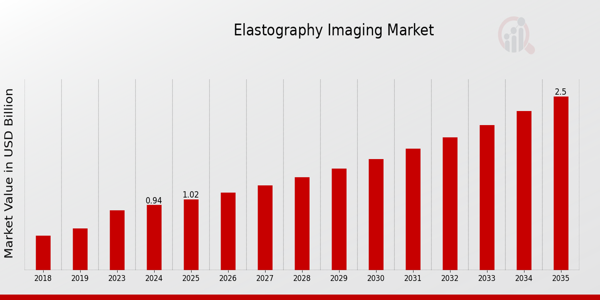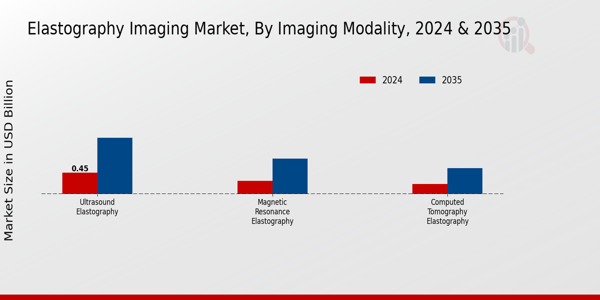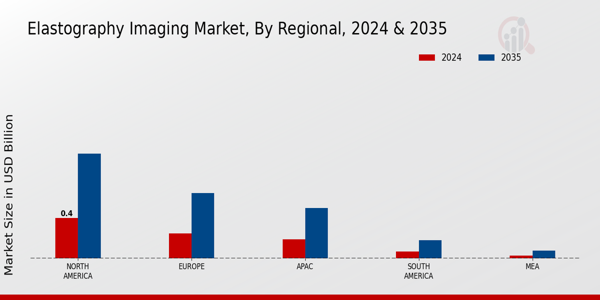Elastography Imaging Market Overview
As per MRFR analysis, the Elastography Imaging Market Size was estimated at 0.86 (USD Billion) in 2023. The Elastography Imaging Market Industry is expected to grow from 0.94 (USD Billion) in 2024 to 2.5 (USD Billion) by 2035. The Elastography Imaging Market CAGR (growth rate) is expected to be around 9.33% during the forecast period (2025 - 2035).
Key Elastography Imaging Market Trends Highlighted
The Global Elastography Imaging Market is experiencing significant advancements driven by various factors. One of the key market drivers is the increasing prevalence of chronic diseases, leading to a higher demand for non-invasive diagnostic techniques. Elastography, known for its ability to assess tissue stiffness, presents a valuable tool in detecting conditions such as liver fibrosis and tumors.
Growing awareness among healthcare professionals about its benefits contributes to its adoption across various imaging modalities. In recent times, there has been a surge in technological innovations, such as enhanced ultrasound and magnetic resonance elastography, which boost the accuracy and efficiency of diagnoses.Furthermore, the integration of artificial intelligence and machine learning with elastography is enabling more precise interpretations, improving patient outcomes.
Opportunities in this market are also bolstered by the untapped potential in developing regions, where advancements in healthcare infrastructure may increase the availability of elastography imaging technologies. Moreover, rising investment in research and development from the public and private sectors indicates a commitment to advancing imaging technologies further.
The push for early disease detection and the overall improvement of healthcare services globally provides a positive outlook for the elastography imaging market.As regulatory bodies continue to support innovation in medical imaging, the global trend appears favorable for elastography due to its non-invasive nature and growing clinical applications. With an ongoing focus on improved patient care and economic efficiency, elastography imaging is set to gain prominence as a critical diagnostic tool in various clinical settings worldwide.

Source: Primary Research, Secondary Research, MRFR Database and Analyst Review
Elastography Imaging Market Drivers
Increasing Demand for Early Disease Detection
The growing need for early illness identification, especially in the field of cancer, is driving considerable growth in the global elastography imaging market. The World Health Organization projects that there will be over 24 million additional instances of cancer worldwide by 2035, a 70% increase in incidence over the following 20 years. This concerning pattern emphasizes the need for sophisticated imaging methods like elastography, which help determine tissue stiffness, especially in the breast and liver, enabling earlier and more precise diagnosis.
Elastography imaging is becoming more and more popular as a result of organizations like the National Cancer Institute and the American Cancer Society actively encouraging the use of technology to improve diagnostic skills. Additionally, elastography technology is being used more and more in clinics and hospitals to enhance patient outcomes, which is driving up demand for this cutting-edge imaging modality worldwide.
Technological Advancements in Imaging Techniques
Continuous technological advancements in imaging techniques are significantly boosting the Global Elastography Imaging Market Industry. Innovations in ultrasound technology, magnetic resonance elastography, and shear wave elastography have improved the accuracy and efficiency of imaging processes.
A recent report from the European Society of Radiology highlighted that advancements such as real-time imaging and enhanced post-processing software are now allowing for quicker and more reliable interpretations of elastic images.These innovations are supported by major companies in the healthcare technology sector, such as Siemens Healthineers and GE Healthcare, further driving the integration of elastography within medical imaging practices globally.
Rising Prevalence of Liver Diseases
The rising prevalence of liver diseases worldwide is becoming a key driver for the Global Elastography Imaging Market Industry. According to the Global Burden of Disease Study, liver diseases are among the leading causes of mortality, with over 2 million deaths globally attributed to liver cirrhosis and other related disorders every year. The increasing incidence of non-alcoholic fatty liver disease, particularly in urban populations, emphasizes the importance of non-invasive diagnostic tools like elastography.
The World Liver Research Foundation has stated that elastography has transformed the assessment of liver fibrosis and stiffness measurement, making it indispensable for managing chronic liver conditions. This trend reinforces the importance of elastography in clinical practice as healthcare providers, including hospitals and specialized clinics, seek effective solutions to address the growing burden of liver diseases.
Elastography Imaging Market Segment Insights
Elastography Imaging Market Imaging Modality Insights
The Global Elastography Imaging Market is experiencing significant growth, particularly within the Imaging Modality segment, which encompasses crucial variations, including Ultrasound Elastography, Magnetic Resonance Elastography, and Computed Tomography Elastography. In 2024, the entire market is valued at 0.94 USD Billion, with a visible upward trajectory leading to a valuation of 2.5 USD Billion by 2035. This segment plays a pivotal role in enhancing diagnostic accuracy through the assessment of tissue elasticity, thus providing critical insights into various medical conditions.
Among the noted modalities, Ultrasound Elastography holds a majority share, valued at 0.45 USD Billion in 2024 and expected to grow to 1.2 USD Billion in 2035. Its prominence can be attributed to its non-invasive nature, real-time imaging capabilities, and cost-effectiveness, making it a preferred choice in clinical practice.
Following closely, Magnetic Resonance Elastography, valued at 0.28 USD Billion in 2024, is poised to reach 0.75 USD Billion by 2035, owing to its ability to provide comprehensive and high-resolution imagery of tissues, thus being instrumental in research and advanced diagnostic scenarios.Meanwhile, Computed Tomography Elastography, initially valued at 0.21 USD Billion in 2024 and expected to rise to 0.55 USD Billion by 2035, presents unique benefits such as enhanced three-dimensional imaging, though it currently represents a smaller fraction of the market.
This market segmentation underscores the diverse applications and increasing adoption of elastography imaging techniques across the healthcare sector, driven by the growing demand for innovative and effective diagnostic tools. Trends in healthcare emphasize the importance of early disease detection and personalized treatment plans, further propelling the demand for elastography imaging modalities.As a key driver, the increasing prevalence of chronic diseases necessitates advanced imaging methods for accurate medical assessments, highlighting the vital role the Global Elastography Imaging Market plays in contemporary healthcare.
Despite the significant potential for growth, challenges such as high initial equipment costs and the need for specialized training for practitioners persist. Nevertheless, opportunities abound in regional markets as technological advancements and increasing investments in healthcare infrastructure pave the way for expanding the Global Elastography Imaging Market.With a growing emphasis on preventive medicine and personalized patient care, the future seems promising for the Imaging Modality segment within the overall landscape of elastography imaging solutions.

Source: Primary Research, Secondary Research, MRFR Database and Analyst Review
Elastography Imaging Market Application Insights
The Application segment of the Global Elastography Imaging Market has emerged as a vital area within the healthcare industry, primarily focusing on diagnostics for various medical conditions. In 2024, this segment is contributed significantly to the overall market's value of 0.94 Billion USD. The increasing prevalence of liver diseases, which affect millions globally, underscores the critical need for advanced imaging techniques to enhance early detection and treatment.
Similarly, the importance of early diagnosis of breast cancer cannot be understated, as it remains one of the leading causes of cancer-related fatalities.Musculoskeletal disorders, exacerbated by aging populations and lifestyle changes, also demand effective imaging solutions to improve patient outcomes. Furthermore, cardiovascular diseases, a leading cause of mortality worldwide, highlight the growing dependency on elastography imaging for safer, non-invasive assessments.
Overall, the segmentation within the Global Elastography Imaging Market data reflects a robust market growth trajectory bolstered by rising incidences of these conditions and the adoption of innovative imaging technologies that foster accuracy in diagnosis and treatment planning.
Elastography Imaging Market End User Insights
The Global Elastography Imaging Market is experiencing substantial growth, with a market value of 0.94 billion USD in 2024, projected to reach approximately 2.5 billion USD by 2035. This expansion is primarily driven by increased demand for non-invasive diagnostic techniques across various End User categories, notably Hospitals, Diagnostic Centers, and Research Institutes. Hospitals utilize elastography imaging for its critical role in enhancing patient care through early diagnosis of soft tissue abnormalities. Diagnostic Centers are significant as they offer specialized imaging services, contributing to a higher volume of elastography procedures.
Research Institutes play a vital role in advancing elastography technology, focusing on developing innovative imaging methods and protocols, which is crucial for improving diagnostic accuracy. The growth of the Global Elastography Imaging Market is further propelled by technological advancements, the rising prevalence of chronic diseases, and a growing awareness of the benefits of elastography imaging in various medical applications, alongside challenges such as high initial equipment costs and the need for skilled technicians. Overall, the market's segmentation reflects a robust landscape that caters to diverse healthcare needs while adapting to the rapid changes in medical technology.
Elastography Imaging Market Technology Insights
The Global Elastography Imaging Market, focused on the Technology segment, is experiencing considerable growth, with the overall market isvalued at 0.94 billion USD in 2024 and projected to reach 2.5 billion USD by 2035. The compounds of this market represent diverse advances in medical imaging technology. Key technologies such as Strain Elastography, Shear Wave Elastography, and Transverse Wave Elastography exemplify different techniques for assessing tissue stiffness, which is essential for diagnosing various medical conditions. Strain Elastography is notable for its simplicity and affordability, allowing for greater accessibility in clinical settings.
Shear Wave Elastography is significant due to its ability to provide quantitative measurements of tissue stiffness with excellent precision, which enhances diagnostic capabilities. Meanwhile, Transverse Wave Elastography is gaining traction for its robustness and accuracy. The demand for these technologies is driven by the rising prevalence of chronic diseases and the growing need for non-invasive diagnostic procedures. Moreover, advancements in imaging techniques and the increasing adoption of elastography in medical practices are reinforcing the Global Elastography Imaging Market statistics, further highlighting the importance of these technologies in enhancing patient care worldwide.
Elastography Imaging Market Regional Insights
The Global Elastography Imaging Market revenue is experiencing growth across various regional segments, with North America leading the way. In 2024, North America is valued at 0.4 USD Billion, reflecting a majority holding in the overall market due to advanced healthcare infrastructure and rising adoption of elastography technologies. Europe follows closely with an estimated value of 0.25 USD Billion in 2024, characterized by significant investments in Research and Development initiatives.
The APAC region, valued at 0.19 USD Billion, is showing promising expansion driven by increasing healthcare access and technological advancements.South America, at 0.07 USD Billion, and the MEA region, valued at 0.03 USD Billion, are also contributing to the market, albeit at a slower pace. These regions present unique opportunities and challenges, such as varying healthcare regulations and technological disparities, impacting the Global Elastography Imaging Market segmentation and promoting different growth trajectories. The increasing prevalence of chronic diseases and the need for non-invasive diagnostic techniques are propelling the market, potentially leading to robust growth in the forthcoming years.

Source: Primary Research, Secondary Research, MRFR Database and Analyst Review
Elastography Imaging Market Key Players and Competitive Insights
The Global Elastography Imaging Market has emerged as a crucial segment within the healthcare industry, focusing on advanced imaging techniques that assess tissue elasticity and mechanical properties. As the demand for non-invasive diagnostic methods continues to grow, numerous players have entered the market, striving to gain a competitive edge through innovative technologies and enhanced product offerings.
The market is characterized by a blend of established companies and emerging players, each vying to expand their presence and leverage opportunities for growth in various applications such as cardiology, oncology, and liver diagnostics. Competitive dynamics are influenced by factors such as technological advancements, regulatory approvals, and partnerships that aim at advancing elastography techniques and expanding their reach in different demographics worldwide.Esaote has carved a distinct niche in the Global Elastography Imaging Market with its commitment to providing high-quality ultrasound products and imaging solutions.
The company has a robust portfolio that includes advanced elastography systems known for their accuracy and reliability in assessing tissue stiffness, which is critical in conditions like liver and breast diseases. Esaote's strengths lie in its technological innovation and focus on research and development, enabling the creation of user-friendly interfaces and precise diagnostic tools that meet healthcare professionals' needs.
The company has also established a strong global distribution network, ensuring its products are accessible to a wide range of medical facilities. Additionally, Esaote’s dedication to education and customer support enhances its reputation and credibility among users, suggesting a solid foundation for sustained competitive advantage in this evolving market.Hologic is a major player in the Global Elastography Imaging Market, renowned for its cutting-edge medical devices and imaging solutions tailored for women's health and other critical areas. The company offers a range of products, including innovative elastography imaging systems designed to enhance diagnostic capabilities in assessing breast and liver anomalies.
Hologic's market presence is supported by its extensive research and development initiatives, resulting in a steady pipeline of new technologies that address patient needs effectively. Moreover, Hologic's strategic mergers and acquisitions have significantly bolstered its capabilities, allowing it to expand its product line and enter new markets more efficiently.
Their focus on delivering high-quality, precise diagnostics, combined with a commitment to educational initiatives for healthcare providers, has established Hologic as a leader within the global elastography imaging landscape, reinforcing its strengths and potential for future growth in this competitive field.
Key Companies in the Elastography Imaging Market Include
- Esaote
- Hologic
- Bracco Imaging
- Fujifilm Holdings Corporation
- Samsung Medison
- Neusoft Medical Systems
- Canon Medical Systems
- QRad
- GE Healthcare
- Hitachi Medical Systems
- SonoScape
- Philips Healthcare
- Olympus Corporation
- Mindray Medical International
- Siemens Healthineers
Elastography Imaging Market Industry Developments
Recent developments in the Global Elastography Imaging Market have shown significant advancements and collaborations among key companies. Esaote has focused on enhancing its ultrasound elastography solutions, while Hologic has been expanding its product line to include advanced imaging technologies.
In June 2023, Fujifilm Holdings Corporation announced the development of new elastography imaging features that enhance diagnostic capabilities, a move that has generated interest in the market. GE Healthcare is also investing in the integration of artificial intelligence algorithms with elastography imaging to improve diagnostic accuracy. Merger and acquisition activities within this sector have seen movement; in August 2023, Siemens Healthineers acquired a controlling interest in an innovator of elastography imaging technologies, strengthening their market position.
In December 2022, Bracco Imaging announced a strategic partnership with Canon Medical Systems to advance elastography applications, demonstrating the ongoing trend of collaboration in the market. The valuation of companies in this sector continues to grow, driven by increasing demand for non-invasive diagnostic imaging solutions. The market is also witnessing technological enhancements, influenced by market players like Philips Healthcare and Hitachi Medical Systems, solidifying the landscape of elastography imaging on a global scale.
Elastography Imaging Market Segmentation Insights
Elastography Imaging Market Imaging Modality Outlook
- Ultrasound Elastography
- Magnetic Resonance Elastography
- Computed Tomography Elastography
Elastography Imaging Market Application Outlook
- Liver Diseases
- Breast Cancer
- Musculoskeletal Disorders
- Cardiovascular Diseases
Elastography Imaging Market End User Outlook
- Hospitals
- Diagnostic Centers
- Research Institutes
Elastography Imaging Market Technology Outlook
- Strain Elastography
- shear Wave Elastography
- Transverse Wave Elastography
Elastography Imaging Market Regional Outlook
- North America
- Europe
- South America
- Asia Pacific
- Middle East and Africa
| Report Attribute/Metric Source: |
Details |
| MARKET SIZE 2023 |
0.86(USD Billion) |
| MARKET SIZE 2024 |
0.94(USD Billion) |
| MARKET SIZE 2035 |
2.5(USD Billion) |
| COMPOUND ANNUAL GROWTH RATE (CAGR) |
9.33% (2025 - 2035) |
| REPORT COVERAGE |
Revenue Forecast, Competitive Landscape, Growth Factors, and Trends |
| BASE YEAR |
2024 |
| MARKET FORECAST PERIOD |
2025 - 2035 |
| HISTORICAL DATA |
2019 - 2024 |
| MARKET FORECAST UNITS |
USD Billion |
| KEY COMPANIES PROFILED |
Esaote, Hologic, Bracco Imaging, Fujifilm Holdings Corporation, Samsung Medison, Neusoft Medical Systems, Canon Medical Systems, QRad, GE Healthcare, Hitachi Medical Systems, SonoScape, Philips Healthcare, Olympus Corporation, Mindray Medical International, Siemens Healthineers |
| SEGMENTS COVERED |
Imaging Modality, Application, End User, Technology, Regional |
| KEY MARKET OPPORTUNITIES |
Increased demand for non-invasive diagnostics, Technological advancements in imaging modalities, Expanding applications in liver disease assessment, Growth in geriatric population requiring imaging, Rising investments in healthcare infrastructure |
| KEY MARKET DYNAMICS |
Increasing demand for non-invasive diagnostics, Technological advancements in imaging systems, Rising prevalence of liver diseases, Growing geriatric population, Expanding applications in oncology |
| COUNTRIES COVERED |
North America, Europe, APAC, South America, MEA |
Elastography Imaging Market Highlights:
Frequently Asked Questions (FAQ) :
The Global Elastography Imaging Market is expected to be valued at 0.94 USD Billion by 2024.
By 2035, the Global Elastography Imaging Market is projected to reach 2.5 USD Billion.
The market is expected to grow at a compound annual growth rate (CAGR) of 9.33% from 2025 to 2035.
North America is projected to dominate the market, reaching a value of 1.04 USD Billion by 2035.
Ultrasound Elastography is expected to be valued at 0.45 USD Billion in 2024.
Magnetic Resonance Elastography is projected to reach 0.75 USD Billion by 2035.
Some major players include Esaote, Hologic, Bracco Imaging, Fujifilm Holdings, and GE Healthcare.
Computed Tomography Elastography is projected to reach 0.55 USD Billion by 2035.
Europe is expected to have a market size of 0.65 USD Billion by 2035.
Key growth drivers include advancements in imaging technology and increasing prevalence of chronic diseases.

















